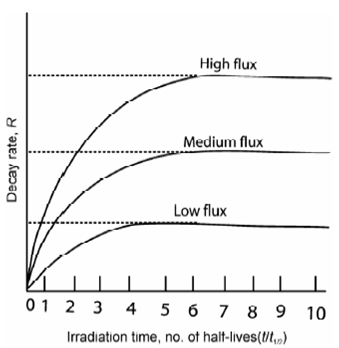Detection limit:
Detection limit is a statistical concept, based on the ability of a measurement method to determine an analyte within a sample matrix, regardless of its source of the origin. Without a precise statistical definition, it is not possible to determine a numerical value for the limit of detection (LOD). In general, all LODs are defined in terms of 3σ where σ is standard deviation for the specimens. Thus detection limit (LD) is defined as 3σ of the standard deviation of the background counts (Cb) under the peak and is calculated using the expression
LD(counts ) = 2.71+ 3.29 × √ C b

Figure: Variation of activity with neutron flux
The counts are then converted to µg g-1 by using S (sensitivity) as sample mass (g). Also activity may be taken as 10,000 counts with 0.1% statistical error and thus the amount or sensitivity may be calculated under experimental conditions. The typical detection limits using a flux of 1013 n cm-2 s-1 are available from the literature. For elements like Eu and Dy, the LD is about 1 pg whereas for Mn, In and Lu, it is 10 pg under normal experimental conditions of INAA. However, sensitivity can be improved if RNAA procedure is followed whereby interfering radionuclides are removed and thus background is lowered.